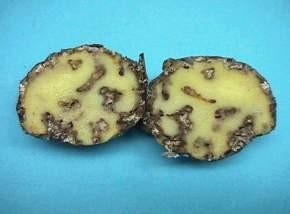


Potato tuber moth (Phthorimaea operculella)
This moth is the most serious pest of potatoes in the region. It occurs in Africa wherever potatoes are grown, and it also attacks tobacco, eggplants and tomatoes. The moth is small (measuring about one mm at rest and with 12 to 16 mm wingspan), brownish grey in colour with narrow fringed wings. The moths are active mainly at dusk, but occasionally they can be seen flying within potato plants. Female moths lay eggs singly or in small batches on sheltered places of the foliage (leaf and stems) and near the eye buds on exposed tubers through cracks in the soil or in the store.
The caterpillars are up to 12 mm long and whitish to pale greenish in colour. They feed as leafminers between the upper and the lower epidermis and bore into the petiole, or a young shoot or main leaf vein and later into the tuber. When eggs are laid on tubers, caterpillars begin feeding on the tubers immediately upon hatching. They pupate in a silken cocoon covered with soil particles and debris among dead potato leaves, soil litter, eyes of tubers, and storage walls and floors.
Caterpillars burrowing in the tubers cause major damage by making long irregular black tunnels filled with excreta, where disease-causing microorganisms grow. These tunnels provide an entry point for various plant pathogens and make the potatoes unfit for human consumption. The pest is transferred with the harvested tubers to the potato store, where it can reproduce and infest other tubers. This may lead to total destruction of the stored crop.
- Conserve natural enemies. They are important for natural control of the potato tuber moth. Ladybird beetles prey on eggs and young caterpillars. Larvae of lacewings, big-eyed bugs, ground beetles, earwigs and rove beetles prey on all stages of the pest. Several native parasitic wasps attack this pest. A granulosis virus has also been found infecting caterpillars in the field (diseased caterpillars have a milky white colouration and are sluggish). However, in many cases control is not satisfactory, therefore several parasitic wasps, native from South America, the area of origin of the pest, have been introduced to several countries in Africa. The most important are Copidosoma koehleri and Apanteles subandinus. These wasps have provided effective control of the pests in several countries, particularly in Southern and Eastern Africa
- Use healthy, clean seed, since infested seed tubers are the main cause of re-infestation in the field.
- Avoid planting in rough soil. Plant as deeply as possible (10 cm deep) and ridge at least 3 times during the growing season. Experiments in Sudan showed that increasing the sowing depth from 2.5 cm practised by farmers to 7.6 cm, significantly reduced damage by the cutworms and the potato tuber moth and resulted in an increase of 3.7 t/ha in marketable yield (Siddig, 1987).
- Ensure compact hilling. This is very important to prevent moths reaching the tubers to lay eggs. It also makes it difficult for caterpillars to reach the tubers. In addition, emerging moths from infested tubers will not be able to emerge through deep soil.
- Provide enough water to prevent soil cracks.
- Mulch the plants with rice straw and/or with leaves. Mulching with neem leaves during the last 4 weeks before harvest significantly reduced insect damage in Sudan. (Ali, 1993).
- Intercrop potatoes with hot pepper, onions or peas.
- Harvest the crop immediately as it matures, as tubers left in fields for longer periods are highly infested.
- At harvesting, ensure that the tubers are not exposed to moths before they are properly protected in the store. All harvested tubers have to be bagged and removed before late afternoon every day.
- Destroy all infested potatoes immediately and remove all plant residues from the field. Caterpillars pupate in the tubers and dry stems left in the field.
- Destroy all volunteer potato plants before planting new potato crops.
- Use alternative pesticides to protect potatoes in store.
- Neem can be applied to reduce damage by the potato tuber moth. For instance, in India a four months protection was achieved when harvested potatoes and the covering material were sprayed with five and 10% enriched neem seed extract (Saxena, 1995). In Sudan spraying neem seed and leaf extracts (1 kg/40 l water) and then placing tubers in jute sacks reduced post harvest losses by the potato tuber moth compared with traditional methods such as leaving the tuber unprotected or covering them with banana leaves only (Siddig, 1987). A neem seed extract was also effective for control of the potato tuber moth on stored potatoes in Egypt (Salem, 1991) . Storage loss after 6 months in potatoes treated with 100ppm neem oil was 25% (compared to 10% with the insecticide carbaryl). Adults from larvae treated with neem oil were deformed. Work in Yemen confirmed the beneficial effect of neem; neem oil and sunflower oil halted the development of caterpillars of the potato tuber moth in storage. However, caution is needed since the oil seemed to interfere with potato respiration, leaving the potatoes very soft with dark tissue (Kroschel, 1995).
- A Bt (Bacillus thuringiensis) preparation in powder form mixed with fine sand (1:25) dusted was very effective in controlling this pest in the store in Yemen and Kenya (Kroschel, 1995). Tuber infestation was also reduced by bedding the potatoes in the leaves of the Peruvian pepper tree (Schinus molle), also known as mpilipili in Swahili, and Eucalyptus sp. (Kroschel, 1995).
- Storing potatoes in layers with branches of lantana is recommended by Kenya Institute of Organic Farming (KIOF) in areas where this pest is present lantana is reported to repel tuber moths.
- Application of plenty of wood ash or diatomite earth may also prevent rapid build up of tuber moth.
